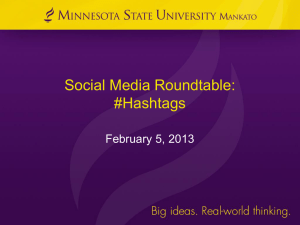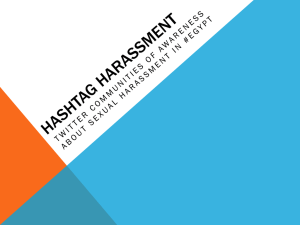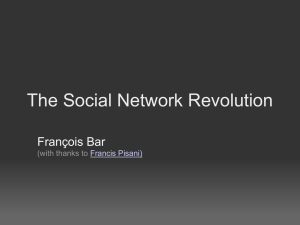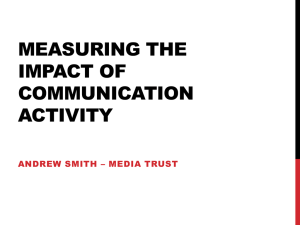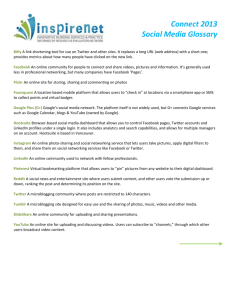Analyzing the Dynamic Evolution of Hashtags on Twitter: a
advertisement
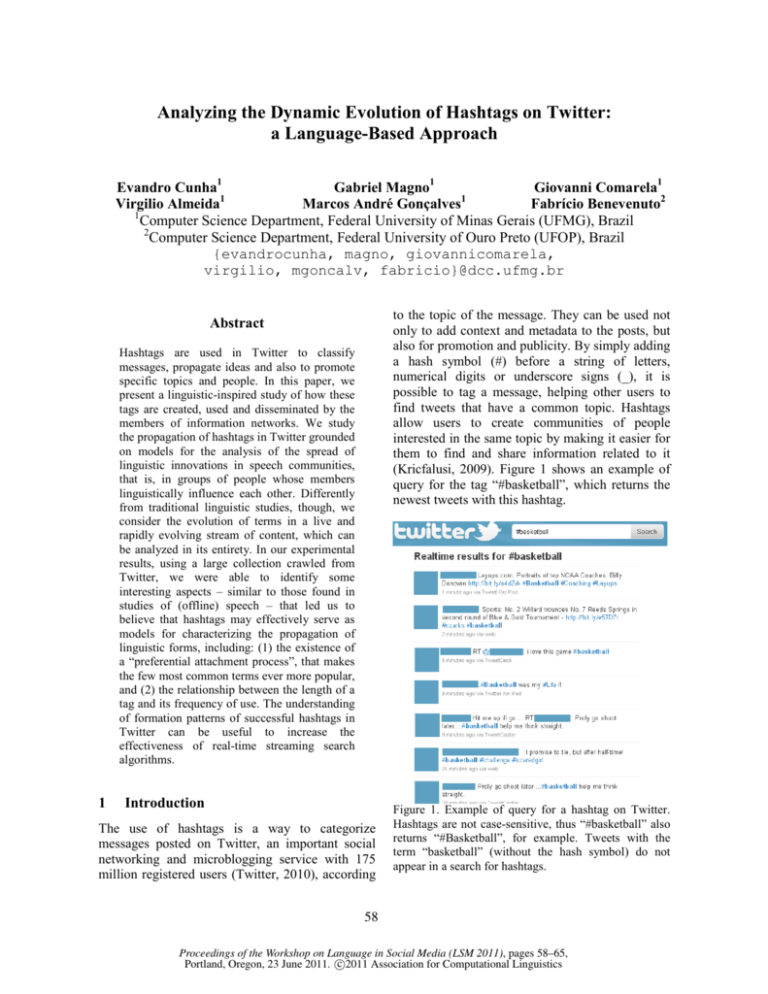
Analyzing the Dynamic Evolution of Hashtags on Twitter:
a Language-Based Approach
Evandro Cunha1
Gabriel Magno1
Giovanni Comarela1
Virgilio Almeida1
Marcos André Gonçalves1
Fabrício Benevenuto2
1
Computer Science Department, Federal University of Minas Gerais (UFMG), Brazil
2
Computer Science Department, Federal University of Ouro Preto (UFOP), Brazil
{evandrocunha, magno, giovannicomarela,
virgilio, mgoncalv, fabricio}@dcc.ufmg.br
to the topic of the message. They can be used not
only to add context and metadata to the posts, but
also for promotion and publicity. By simply adding
a hash symbol (#) before a string of letters,
numerical digits or underscore signs (_), it is
possible to tag a message, helping other users to
find tweets that have a common topic. Hashtags
allow users to create communities of people
interested in the same topic by making it easier for
them to find and share information related to it
(Kricfalusi, 2009). Figure 1 shows an example of
query for the tag “#basketball”, which returns the
newest tweets with this hashtag.
Abstract
Hashtags are used in Twitter to classify
messages, propagate ideas and also to promote
specific topics and people. In this paper, we
present a linguistic-inspired study of how these
tags are created, used and disseminated by the
members of information networks. We study
the propagation of hashtags in Twitter grounded
on models for the analysis of the spread of
linguistic innovations in speech communities,
that is, in groups of people whose members
linguistically influence each other. Differently
from traditional linguistic studies, though, we
consider the evolution of terms in a live and
rapidly evolving stream of content, which can
be analyzed in its entirety. In our experimental
results, using a large collection crawled from
Twitter, we were able to identify some
interesting aspects – similar to those found in
studies of (offline) speech – that led us to
believe that hashtags may effectively serve as
models for characterizing the propagation of
linguistic forms, including: (1) the existence of
a “preferential attachment process”, that makes
the few most common terms ever more popular,
and (2) the relationship between the length of a
tag and its frequency of use. The understanding
of formation patterns of successful hashtags in
Twitter can be useful to increase the
effectiveness of real-time streaming search
algorithms.
1
Introduction
The use of hashtags is a way to categorize
messages posted on Twitter, an important social
networking and microblogging service with 175
million registered users (Twitter, 2010), according
Figure 1. Example of query for a hashtag on Twitter.
Hashtags are not case-sensitive, thus “#basketball” also
returns “#Basketball”, for example. Tweets with the
term “basketball” (without the hash symbol) do not
appear in a search for hashtags.
58
Proceedings of the Workshop on Language in Social Media (LSM 2011), pages 58–65,
c
Portland, Oregon, 23 June 2011. 2011
Association for Computational Linguistics
As hashtags are created by the users
themselves, a new social event can lead to the
simultaneous emergence of several different tags,
each one generated by a different user. They can
either be accepted by other members of the
network or not. In this manner, some propagate
and thrive, while others die immediately after birth
and are restricted to a few messages.
Similarly, lexical innovations occur when new
terms are added to the lexicon of a language, either
through the creation of new words, the reuse of
existing words or the loan from other languages,
for example. An innovation tends to come from
one speaker, who proposes it to other members of
his speech community – i.e., to whom he is
connected in a network of linguistic contacts and
influences. Afterwards, these speakers make a
cultural selection of the innovation, accepting it or
rejecting it.
In the context of the network theory, Figure 2
indicates two moments of a novelty’s propagation
process: the precise time of the innovation (left)
and a later point (right), when some individuals
have accepted the innovation, while others,
although possibly knowing it, didn’t. An
innovative linguistic form can get, for some
reason, some prestige, and maybe speakers begin
to use it, taking it under certain circumstances and
transforming it into a variation of the previously
hegemonic form.
Figure 2. Subgraphs from our Twitter dataset showing
two distinct moments in the process of spreading an
innovation. The black nodes indicate individuals who
joined the innovation (in this case, the hashtag
#musicmonday) at a given moment; the white ones
indicate individuals who didn’t. The links represent
follower relationship.
The diffusion of innovations, be they linguistic,
behavioral, technological, etc., occurs through a
cascade in which the network members,
consciously or not, make choices, taking into
59
account a number of factors that determine which
forms, behaviors or technologies are more
advantageous to be adopted in a given moment
(Easley and Kleinberg, 2010).
An important question in the field of linguistics
is: how can an initially rare variant spread to an
entire linguistic network, or speech community
(Sapir, 1921)? How does the linguistic change take
out (Silva, 2006)? This change, consisting in the
dissemination of less common variants to much of
the network or even across the entire network, can
be seen as an unexpected fact. However, it occurs.
Thus, to better understand the phenomenon of
language change, it seems essential to understand
the propagation behavior of innovative forms.
Understanding how these forms spread – how and
where they are born, who are the major
disseminators, which network features allow
greater dissemination – is the main objective of our
research group.
In this work, we examine aspects of the
dissemination of hashtags in Twitter, aiming at
understanding the process of propagation of
innovative hashtags in light of linguistic theories.
The utilization of an online social network’s
dataset allows the review of a linguistic system in
its entirety, thereby eliminating the need to work
with sampling. It also allows the verification of
temporal propagation, enabling a more precise
understanding of the path followed by innovations
in the network.
Here, we seek to answer mostly two questions:
(1) does the distribution of the hashtags in
frequency rankings follow some pattern, as the
words in the lexicon of a language? (2) Is the
length of a hashtag a factor that influences to its
success or failure? Our assumption is that
identifying linguistic features related to the
creation and usage of hashtags in Twitter may raise
awareness about individuals’ tagging behavior
over networks, which is an interesting topic in the
field of Network Sciences, Sociology and Social
Psychology. Beyond that, this kind of analysis
should be interesting to optimize tag
recommendation systems not only on Twitter, but
on many other online environments, and to
increase the effectiveness of real-time streaming
search algorithms.
In the next section, we will discuss related
works in Linguistics and in Computer Science. We
try to always keep contact with linguistic theories,
as we believe that complex issues, involving many
aspects together, can be better analyzed through a
multidisciplinary approach. The following sections
cover discussions and the empirical research that
was conducted during this study.
influence curve decays. We analyze hashtags as
well, but in a different perspective, concentrating
on the characteristics that they may have in
common with natural language.
3
2
Related work
Much has been written about linguistic
innovations, language variation and language
change since Weinreich et al. (1968), which is
considered one of the ground works for
sociolinguistics. More recently, Troutman et al.
(2008) conducted a study with the purpose of
simulating language change in a speech
community. They built a computational model
based on characteristics from language users and
from social network structures and tested it in
different scenarios,
obtaining a probabilistic
model that captures many of the key features of
language change. Our work extends the traditional
way of conducting research on sociolinguistics as
we used a corpus of non-natural language data and
even so we found compatible results to the ones
obtained from natural language data.
Kwak et al. (2010) were the first to study in a
quantitative way the topological characteristics of
Twitter, information diffusion on it and its power
as a new medium of information sharing. Their
analyses are in some way related to the ones we
perform here. Chew and Eysenbach (2010) led a
study that investigated the keywords “swine flu”
and “H1N1” on Twitter during the 2009 H1N1
pandemic. The goals of this work were to monitor
the use of these terms over time, to conduct a
content analysis of tweets and to validate Twitter
as a trend-tracking tool. They found the existence
of variability in the use of the terms, which is a
constitutive aspect of human language. Our
findings complement, with more focus on the
linguistic approach, what they have discovered,
revealing new aspects that can link the creation of
hashtags to linguistic innovations.
Romero et al. (2011) studied the mechanics of
information diffusion on Twitter. They analyzed
the phenomenon of the spread of hashtags, but
focusing on the variations of the diffusion features
across different topics. Their work introduces the
measures “stickiness” – the probability of adoption
of one hashtag based on the number of exposures –
and “persistence” – which captures how rapidly the
60
Dataset and methodology
In our study, we use a dataset consisting of about 2
billion follow links among almost 55 million users.
Twitter allowed the collection of data for each
existing user, including their social connections,
and all the tweets they ever posted. Out of all
users, about 8% of the profiles were set private by
the users themselves, and only authorized
followers could view their tweets. We ignore these
users in our analysis. In total, we analyzed more
than 1.7 billion tweets posted between July 2006
and August 2009. For a comprehensive description
of the data collected we refer the reader to Cha et
al. (2010).
As, in some of our analysis, we intend to
compare features of the variation of hashtags to
linguistic variation, we must find interchangeable
hashtags, i.e., different tags used with the same
purpose, to characterize messages on the same
topic. This corresponds to the basic feature of
variant linguistic forms, which are used by
different speakers, or at different moments, to
name the same object, action etc. Aiming to find
interchangeable hashtags, we collected tweets on
specific topics. In this way, we could verify the
existence of different hashtags used to categorize
messages that could be grouped into one category.
For example, hashtags like #michaeljackson #mj,
#jackson, among many others, refer to the same
subject and in a managed environment they would
probably be condensed under only one tag.
We selected three relevant topics of this period,
namely: Michael Jackson (the singer’s death has
been widely reported in the social networks),
Swine Flu (the epidemic of H1N1 was a major
issue of 2009), and Music Monday (this topic is
related to a very successful campaign in favor of
posting tweets related to music on Mondays).
Then, we built one minor base for each one of the
topics: MJ (referring to Michael Jackson), SF
(referring to Swine Flu) and MM (referring to
Music Monday). These bases were formed by
filtering tweets that: (1) included at least one
hashtag and (2) included at least one of the
following terms that we considered related to the
topics: “michael jackson” (for the base MJ),
“swine flu” or “#swineflu” (for the base SF), and
“#musicmonday”
(for
the
base
MM).
Consequently, in the base MJ, for example, we
gathered all the tweets that included the term
“michael jackson” and that had at least one
hashtag, even if this tag had no direct relationship
with the topic.
Table 1 presents data from each base: number
of tweets posted, number of users who posted
tweets, number of follow links among users of the
base and number of different hashtags used in the
tweets of the base.
individuals when they feel the need to categorize
their messages with a term not yet used for this
purpose. This reflects the speaker’s need to create
a term, for example, to name an object or an action
that he/she was not acquainted with in the offline
world.
Just like hashtags can fail and be used only
once, a linguistic innovation may not exceed the
boundaries of its creator’s language. An innovation
can be used in a specific situation and fall into
oblivion, like many linguistic forms which are lost
without even being recorded.
4.2
Directionality of the graphs
The directionality of both networks we are
studying, i.e. Twitter and speech communities, in
addition to the resemblance between the creation
of hashtags and linguistic innovations, is an
important similarity between these systems. It led
to the hypothesis that these structures would have
more issues in common.
In this section, we discuss these qualitative
similarities, in order to justify the following
quantitative comparisons.
Twitter’s network can be described as a directed
graph. On this social network, relations between
users are not necessarily symmetrical, which
means that it is possible for someone to follow
another person without being followed by him/her.
This is very clear when we talk about celebrities
who have millions of followers, but at the same
time follow only a few users.
This characteristic corresponds to the general
absence of directionality of offline social networks.
Not only on Twitter the edges can go one-way: in
the “real world”, we are somehow connected to
celebrities, athletes and famous politicians, and we
hear what they say. We are all part of the same
speech community, in the sense that a celebrity is
able to influence the way we use language.
However, they certainly do not even know who we
are: it is like on Twitter’s graph, where we follow
them, but they do not follow us.
4.1
5
Follow
Different
links
hashtags
MJ 221,128 91,176
3,171,118
19,679
SF
295,333 83,211
5,806,407
17,196
MM 835,883 196,411 7,136,213
16,005
Table 1. Summary information about the bases built.
Base
4
Tweets
Users
Comparing Twitter
linguistic system
to
a
natural
Hashtags and linguistic innovations
A linguistic innovation can be described as any
change in any existing language system (Breivik
and Jahr, 1989). In linguistics, to say that there was
an innovation means that there was a modification,
a transformation, in any part of the language –
phonetics, phonology, syntax, semantics etc. This
novelty is neither degeneration, nor an
improvement: language changes and evolves, as a
living being, in order to adapt itself to the society
in which it is inserted.
We use linguistic knowledge to analyze and
explain phenomena related to the creation, usage
and dissemination of hashtags. We see similarities
between these two systems: like linguistic
innovations, new hashtags are created by
61
Rich-get-richer phenomenon and Zipf’s
law
Easley and Kleinberg (2010) characterize what is
known as “rich-get-richer phenomenon” or
“preferential attachment process”: in some
systems, the popularity of the most common items
tends to increase faster than the popularity of the
less common ones. It generates a further spread of
the forms that achieve a certain prestige.
Zipf (1949) examined and confirmed that the
frequency of words in English and in other
languages follow a power law. Aiming to verify if
any kind of pattern is followed in the tags
distribution, we analyzed our data from Twitter.
Tables 2 and 3 display information on the
distribution of hashtags in each of the bases
studied. By “i-tweet hashtags”, we mean the
hashtags that appear in at most i tweets. They are
the less common ones. By “j-tweet hashtags”, we
mean the hashtags that appear in at least j tweets,
that is, the most popular ones.
Base
MJ
SF
MM
Table
base.
Base
MJ
SF
MM
Table
base.
% of i-tweet hashtags inside the base
i=1
i=2
i=10
59%
72%
88%
59%
73%
92%
60%
74%
91%
2. Distribution of less common hashtags of each
number of j-tweet hashtags inside the base
j=10,000
j=5,000
j=1,000
3
6
28
3
4
14
2
3
28
3. Distribution of most popular hashtags of each
The percentage of hashtags according to the
number of tweets in which they appear are
remarkably very similar in the three bases. It seems
to confirm the possible existence of a “rich-getricher” pattern: few hashtags – the most popular
ones – are used in most of the tweets, while the
vast majority of them are used in only a few posts.
Table 2 shows that around 60% of hashtags are
used only once in tweets of the respective base, i.e.
do not propagate to the rest of the network; around
90% of them are not used more than ten times,
which shows that the great part of the hashtags get
restricted to only one user or to a very small
community of users.
On the other hand, just like Zipf (1949) showed
for natural languages, the most used hashtags get
very high frequencies of use. Table 4 shows data
from the three most used hashtags in each of the
bases and makes clear that, also on Twitter, a
person´s behavior depends on the choices made by
other people (Easley and Kleinberg, 2010).
Complementing these data, Figure 3 associates
the position of a hashtag in a popularity ranking
(based on the number of times that a hashtag has
been used) to the volume of tweets in which it
appears. A plot in log-log coordinates, where x is a
rank of a tag in the frequency table and y is the
total number of the tag’s occurrences in tweets,
shows that the distribution of hashtags on Twitter
also follow the general trend of a Zipfian
62
distribuction, appearing approximately linear on
log-log plot.
Base
MJ
SF
MM
Most used
#michaeljackson
35,861
12.3%
#swineflu
230,457
51.5%
#musicmonday
824,778
79.7%
2nd most used
#michael
27,298
9.3%
#h1n1
70,693
15.8%
#musicmondays
11,770
1.1%
3rd most used
#mj
16,758
5.7%
#swine
12,444
2.8%
#music
5,106
0.5%
Table 4. Data from the most used hashtags of each base.
Below each hashtag are given the number of times it
was used and the percentage that it represents of the
total use of hashtags in the base.
Figure 3. A log-log plot showing volume of tweets in
which the hashtag was used vs. its position in a
popularity ranking.
Only three values on the left, which refer to
tags that occupy the top positions in the frequency
ranking (and thus were used more often), are not
well described by the interpolations: the most
frequent tag on MM base and the two most
frequent ones on SF base. This is due to the very
high usage of these hashtags: #musicmonday
appeared in almost 830,000 tweets of its base;
#swineflu, in more than 230,000; and #h1n1, in
more than 70,000. The other values, however,
show that this is a very good fitting model for our
purposes.
It is interesting to notice the similarity of results
despite being completely different topics. Even the
slopes of the interpolation curves are similar,
varying from -1.037 to -1.163.
6
Hashtag length and frequency
Each word or phrase spoken by someone tells a
story and reflects characteristics of this individual
and his/her group. According to the Theory of
Language Variation and Change (Weinreich et al.,
1968; Labov, 1995, 2001), lexical choice is the
result of a series of social interactions that make up
and form, little by little, the individual speech.
Naturally, these interactions and influences are so
subtle that we ourselves hardly realize them:
gender, age, location, social role, hierarchical
position in an organization – all this reflects the
way we use language in various situations of
everyday life. Understanding what makes speakers
choose one of the forms in variation, in certain
situations, is one of the goals of Sociolinguistics.
In addition to these social factors that influence
the way we express ourselves, described by Labov
(2001), there are also many strictly linguistic
factors which perform such influence, as Labov
(1995) presents. One of these factors seems to be
the length of the words, as noted by Zipf (1935)
and analyzed by Sigurd et al. (2004).
Zipf (1935) suggests that the length of a word
tends to bear an inverse relationship, not
necessarily proportionate, to its relative frequency.
Sigurd et al. (2004) analyze data from different
text genres in English and Swedish and corroborate
the hypothesis, showing that longer words tend to
be avoided, presumably because they are
uneconomic.
Given this evidence, and considering the
concern of Twitter users to save space, since the
maximum size of each tweet is 140 characters, we
investigate whether the length of a hashtag is one
of the strictly linguistic factors that influence on
their success or failure.
In order to carry out this analysis, we compared
the length of the most popular hashtags in each of
the bases with the less popular ones. We noticed
that the most popular ones are simple, direct and
short; on the other hand, among those with little
utilization, many are formed by long strings of
characters. Table 5 displays preliminary
information about the length of hashtags and
popularity and shows that hashtags formed by 15
63
or more characters are not present among the most
used tags.
Table 6 lists the average length, in number of
characters, of different groups of hashtags, divided
according to their positions in the ranking of
frequency of each base.
Most common
hashtags
(number of tweets)
#michaeljackson (35,861)
#michael (27,298)
#mj (16,758)
#swineflu (230,457)
#h1n1 (70,693)
#swine (12,444)
#musicmonday (824,778)
#musicmondays (11,770)
#music (5,106)
Most common hashtags
with 15 or more characters
(number of tweets)
#nothingpersonal (962)
#iwillneverforget (912)
#thankyoumichael (690)
#swinefluhatesyou (1,056)
#crapnamesforpubs (145)
#superhappyfunflu (124)
#musicmondayhttp (540)
#fatpeoplearesexier (471)
#crapurbanlegends (23)
Table 5. Confrontation of most common hashtags and
most common 15-character hashtags. In front of each
hashtag is given the number of times it was used in
tweets of the base.
Average length of...
Topic
MJ
SF
MM
...the k most popular hashtags
k=10
7.1
5.3
9.5
k=20
6.85
7.35
8.4
k=30
7.8
7.17
7.27
k=40
8.02
7.2
6.4
k=50
7.74
7.04
5.92
...the less
popular
hashtags
10.16
10.3
11.66
Table 6. Average length of the most and the less popular
hashtags. The samples with the less popular hashtags
were formed by 50 randomly selected hashtags among
those which appeared only in one tweet of each base.
In all of the bases, the average length of the
most popular hashtags is considerably lower to the
average length of the less popular ones. Figure 4
compares data from Table 6, including information
about standard deviation. It is clear that the
differences between the lengths of the few most
popular tags are not relevant, as the average
lengths of the k most popular tags, with
k={10,20,30,40,50}, are roughly similar and do not
follow a fixed pattern. However, the comparison
with 1-tweet hashtags (less popular ones) shows
important differences which led us to believe that
the length of a hashtag may be an internal factor –
or a strictly linguistic factor – that determines the
success or the failure of tags on Twitter, even if
more accurate study is needed at this point.
This reflects the small number of hashtags
composed of complete sentences (such as
#mileycometobrazil, #herewegoagain and many
others) occupying good positions in the popularity
rankings. Their low standard of success can be
attributed to some reasons besides their increased
length, such as: (1) sentences admit high rate of
variation (e.g. #thankyoumichael, #thanksmj,
#michaeljacksonthanks), which reduces the
frequency of each of the competing forms; (2)
sentences are more difficult to memorize, as they
may accept different word orders; and (3) in
sentences, it seems to be more prone to
misspellings (as in #thanktyoumichael), maybe
because of the apparent difficulty of reading the
terms without the ordinary spaces between them
(we believe that it is easier to notice the
misspelling in "thankt you michael" than in
"thanktyoumichael", though this is an assumption
that must be verified through more extensive work
in Psycholinguistics and Applied Linguistics).
with no more than 246 tweets; #music_monday
wasn’t even used. Table 7 shows the use of sign _
in hashtags. Here, we call a “_-hashtag” any
hashtag in which has been used the sign _.
% of _-hashtags among i-tweet
Number
hashtags
of _hashtags
i=2
i=10
MJ 251 (1.2%)
89%
97%
SF
155 (0.9%)
87%
97%
MM 143 (0.9%)
89%
98%
Table 7. Distribution of hashtags containing the sign
“_”.
Base
We can observe that almost all of the _-hashtags
have lower positions in the popularity rankings: at
least 97% of them are used in 10 or less tweets,
which seems to indicate rejection to this sign. Once
again, the distributions corresponding to each of
the bases are similar, suggesting a uniform
behavior across the whole network.
8
Figure 4. Average number of characters of the most
popular hashtags and of a randomly selected sample of
50 less common tags.
7
Underscores in hashtags
We conducted an analysis to check the influence of
the only sign allowed in the formation of hashtags
besides letters and numbers: the underscore (_). In
all the bases, the use of the sign _ led the hashtags
to low popularity rankings: #michael_jackson
reached position 248 in its base, with only 128
tweets; #swine_flu reached position 67 in its base,
64
Conclusion
This paper examines, through a language-based
approach, some issues concerning the formation
and the usage of hashtags on Twitter. We proposed
that linguistic theory could be used to formulate
hypothesis on online systems like Twitter and our
analysis showed not only qualitative, but also
quantitative similarities between offline and online
speech communities.
We revealed interesting aspects about the
distribution of hashtags according to their
popularity, associating it to the distribution of
words in frequency rankings. We also went further
on the question suggested by Romero et al. (2011),
who proposed to consider what distinguishes a
hashtag that spreads widely from one that fails to
attract attention: we could find that the tag’s
length, for example, is one of these factors. This
kind of analysis can be a useful tool for tag
recommendation
systems
in
different
environments, but there are a number of other
aspects which can be considered in future work
and that can collaborate to the study of human
tagging behavior.
References
Breivik, L.E., and Jahr, E.H. (Eds.) 1989. Language
change: Contributions to the study of its causes.
Berlin/New York: Mouton de Gruyter.
Cha, M., Haddadi, H., Benevenuto, F., and Gummadi,
K.P. (2010). Measuring user influence in Twitter:
The million follower fallacy. Int’l AAAI Conference
on Weblogs and Social Media (ICWSM’10).
Washington DC, USA.
Chew C., and Eysenbach G. 2010. Pandemics in the age
of Twitter: Content analysis of tweets during the
2009 H1N1 outbreak. PLoS ONE 5(11): e14118.
doi: 10.1371/journal.pone.0014118
Easley, D., and Kleinberg, J. 2010. Networks, crowds,
and markets: Reasoning about a highly connected
world. Cambridge: Cambridge University Press.
Kricfalusi, E. 2009. The Twitter hash tag: What is it and
how
do
you
use
it?
Retrieved
from
http://tinyurl.com/bw85z2
Kwak, H., Lee, C., Park, H., and Moon, S. 2010. What
is Twitter, a social network or a news media?
International World Wide Web Conference (WWW
2010). Raleigh, USA.
Labov, W. 1995. Principles of linguistic change:
Internal factors. Reprint. Oxford/Cambridge:
Blackwell.
Labov, W. 2001. Principles of linguistic change: Social
factors. Oxford/Cambridge: Blackwell.
Romero, D., Meeder, B., and Kleinberg, J. 2011.
Differences in the mechanics of information
diffusion across topics: Idioms, political hashtags,
and complex contagion on Twitter. International
World Wide Web Conference (WWW 2011).
Hyderabad, India.
Sapir, E. 1921. Language: An introduction to the study
of speech. New York: Harcourt, Brace and World.
Sigurd, B., Eeg-Olofsson M., and Van de Weijer, J.
2004. World length, sentence length and frequency –
Zipf revisited. Studia Linguistica 58(1), (pp.37-52).
Oxford/Malden: Blackwell.
Silva, L.G. 2006. A dimensão sociolingüística do Atlas
Lingüístico do Brasil. Anais da VIII Semana de
Letras da Universidade Federal de Ouro Preto. Ouro
Preto, Brazil: Universidade Federal de Ouro Preto.
Troutman, C., Clark, B., and Goldrick, M. 2008. Social
networks and intraspeaker variation during periods of
language change. Proceedings of the 31st Annual
Penn
Linguistics
Colloquium.
(pp.325-338).
Philadelphia: University of Pennsylvania.
65
Twitter, 2010. About Twitter: A few Twitter facts.
Retrieved from http://twitter.com/about.
Weinreich, U., Labov, W., and Herzog, M. 1968.
Empirical foundations for a theory of language
change. In Lehmann W., and Malkiel Y. (Eds.),
Directions for historical linguistics (pp.97-195).
Austin: University of Texas Press.
Zipf, G.K. 1935 (reprinted 1965). The psycho-biology of
language. Cambridge: MIT Press.
Zipf, G.K. 1949. Human behavior and the principle of
least effort. Cambridge: Addison-Wesley.
